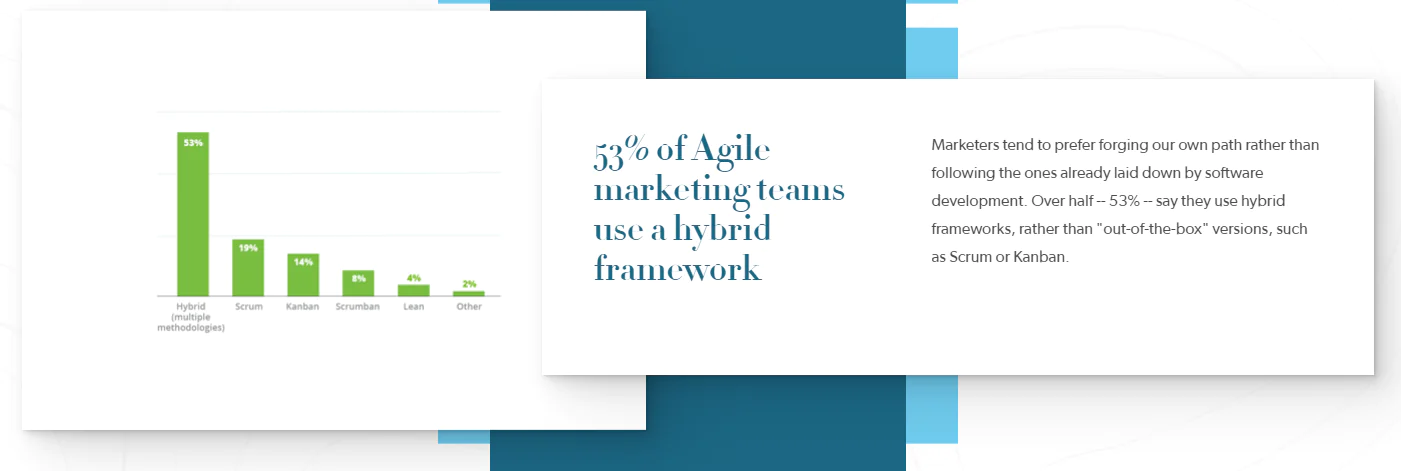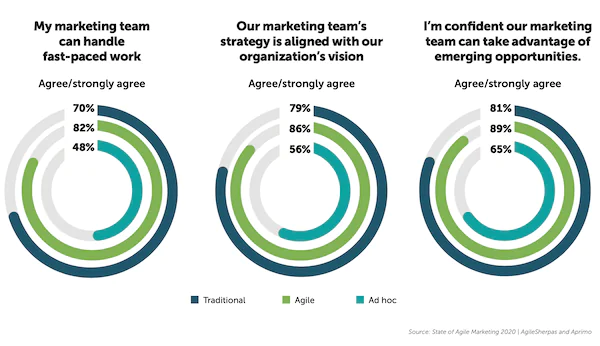In a webinar that we hosted, Andrea Fryrear, co-founder of Agile Sherpas, highlights the problems of Agile Marketing and how Kanban adaptations can help Agile marketers to overcome those problems. This article summarizes the ideas put forward by Andrea Fryrear and we hope you find it helpful. You can watch the full webinar here!
Regards
Simli Saha
The 4th Annual State of Agile Marketing Report by Agile Sherpas shows quite interesting approaches to the adoption of agile marketing by marketers. 51% of marketers report using Agile to manage their work, and 53% of Agile marketing teams use a hybrid framework.
The survey also indicated that when marketers plan to start adopting agile, they reach out to groups within the organization who have already implemented Agile as their guide. Naturally, a group they frequently reach out to is the software and/ or the IT organization as they are typically the most experienced in Agile. As a result, marketers usually choose Scrum which is one of the most popular Agile methods adopted by software and IT teams. Marketers end up believing that Scrum is the only/ best answer to any and every challenge they face in Marketing. However, this is not the best approach to implementing agile, whether in marketing or outside of it.
According to the same State of Agile Marketing Report, marketing teams that have gone through a proper agile transformation use a hybrid system of agile marketing taking practices from various frameworks, including Scrum, Kanban, XP, and others. This is a better pragmatic approach as these frameworks were not designed for Marketing – so using their best practices, it is possible for marketing teams to build their own unique system that works for them.
The ideal approach to Agile Marketing is to use a Scrumban (Scrum+Kanban) approach, which combines various practices that make life easy for marketers as they deal with various other teams within the organization starting from sales to C-suite to customer service. Scrumban integrates various other models and frameworks, thereby giving it the hybrid shape, through the Theory of Constraints which is very popular in the creative world. Scrumban practices are directed towards meeting the needs of the organization as well as the teams.
Agile and scrum help to identify several issues for marketers and Kanban practices provide them with the necessary tools to solve these problems in an efficient manner.
Here are some key challenges faced by Agile Marketing teams and how Scrumban practices help them address these challenges.
Problems of Agile Marketing
- System Bottlenecks: Bottlenecks build-up when the marketing teams jump into the agile practice part without properly re-organization themselves in a more cross-functional way. Consequently, specific teams or roles – such as creative design – which tend to work with multiple teams – become a constraint – a bottleneck – and end up delaying everyone. In such a scenario, adding very strict scrum practices only aggravate the situation rather than solving problems. Using some of the practices from Kanban such as visualizing Flow, defining explicit policies, and implementing WIP limits – and even doing a bottlenecks workshop – helps them resolve these bottlenecks.
- Doing the Right Work: A second big issue for marketing teams (and in fact any other team) is to see if they are working on the right things at the right time. If the right work is being done at the right time is one of the major questions that arise in the mind of every marketer. Modern marketing involves a lot of work starting from learning new tools to writing engrossing content, designing beautiful graphics, analyzing reports and activities, HTML/CSS coding for the landing pages, engaging with visitors on the social media handles, and so on. Given that so many things need to be done, it becomes very important for marketers to know if they are doing the right thing at the right time. Kanban practices provide tools such as class of service (or work item types) as well as swimlanes in a Kanban board to identify different types of work that the team needs to be working on – and ensure that they have or get the right level of staffing and other resources to do that work.
- Lots of Handoffs: Hand-offs, where one team needs to wait for another to complete some work, are a common problem in an agile environment. The more frequent the hand-offs are, the more damaging they are to the team’s productivity. With too many hand-offs, it’s difficult to progress the project. So it’s imperative to minimize or eliminate, hand-offs if the delivery has to be done on time. Therefore, it is advisable for marketers to achieve T-shaped skills where they have deep specialist skills or expertise in one area, along with a breadth of knowledge in multiple areas to help the team with tasks beyond their specialized skills when needed. At the same time, using a time-boxed approach helps teams to do work in smaller chunks and make continuous progress, with a greater chance of meeting the end goals instead of up-front planning in an uncertain environment where you are sure to miss the objective because the objective changed.
Scrumban Adaptations for Agile Teams
The following scrumban adaptations help agile marketers overcome the problems outlined above:
- Visualize Workflow: Proper visualization of workflow actually plays a pivotal role in work management. A complex board often hinders teams from tracking each other’s progress, thereby creating confusion regarding the amount of work done and the backlog. About 38% of the agile marketers struggle to deal with the complexity of the board as they lack proper training. Therefore, for any marketing team who is just getting started with agile, it is better to start with simple visualization and the basics. A simple Kanban board is the best way to do the job initially and then climb the ladder gradually to more sophisticated board/ workflow designs.
- Explicit Policies: Defining explicit policies helps teams define how work is supposed to get done in different stages of the overall workflow. This becomes especially important when there are dependencies with other teams or external stakeholders. If a work item is sitting with an external team or customer, then it need not stay on the Kanban board till it comes back. Deciding to move that work item to a separate holding area – and prioritizing that work when it comes back helps the teams to finish what they already started rather than take up new work items from the backlog.
- Work-In-Progress (WIP) Limits: Another crucial adaptation that agile marketers can implement is the work-in-progress (WIP) limit. WIP Limits are a cornerstone of the Kanban method, which encourage teams to not take up too much work and do multi-tasking but instead focus on finishing what is already on their plate before taking up something new. This also reduces context switching in a dramatic fashion – and helps teams reduce the time wasted or lost in completing work that they take up.
- Introduce Work Item Types: Introducing work item types on teams and bucketing each work based on the level of urgency helps in strategically prioritizing the right work at the right time. When the marketers have too much work to handle, instead of wasting too much time to completely understand and map out every new project or piece of work that comes into the team, they can put the work in the specific buckets which then helps others to know how to deal with the work. Here, a granular visualization plays an important role, and introducing horizontal swimlanes to segregate the work items provides an elegant solution to a complex situation.
- Time Boxing: For any marketing team, starting up with a project and finishing it on time is of utmost importance. Herein comes the utility of the timebox. A timebox places a time limit on a task or activity and helps in determining when a team must complete something, thereby, minimizing the risk of long-term project planning and achieving successful results. Timeboxing is also less sensitive to disruptions in the inflow of work and is better able to handle changes to the scope of work.
Pilot Team And a Scope to Grow Continuously
The preceding sections illustrate how agile teams can benefit from Kanban/ Scrumban adaptations to solve some of the common challenges they face.
There is also a risk that at a certain point in time, the marketing team becomes too satisfied with the result and stops to experiment any further. In this situation, there is benefit in developing the notion of a cross-functional pilot team that may experiment with various agile adaptations. They can identify the opportunities in the workflow, plan how the present process can be improved, execute the changes, review if the changes are working for the team, and then gradually implement the improvements in all other teams as well.
The Wrap Up
While the boundary between the marketing and software world is gradually fading, the Agile practices for both teams need not be the same. Scrum, despite being the popular choice for marketers when starting with agile practices, often fails to provide a suitable environment for them. Kanban can come as a savior that helps agile marketers overcome the various challenges they face after adopting Agile. The flow-based Kanban practices do the job for the marketers and help them become more effective Agile marketers.
If you are one of those Agile marketers facing difficulties with Agile and would like to implement Kanban, then SwiftKanban may be the answer for you.








